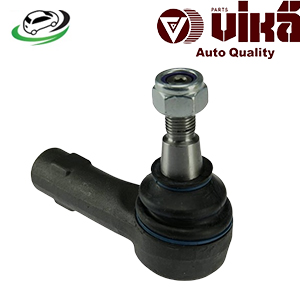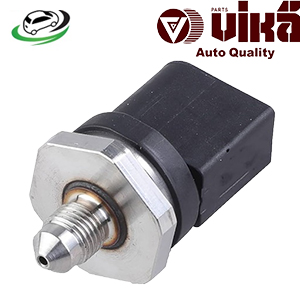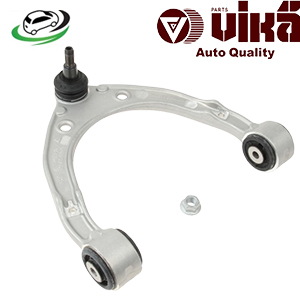-4%
Get Volkswagen Touareg Front Upper Control Arm 7P0407021
The front upper control arm is a vital component of a vehicle’s suspension system, playing a key role in maintaining proper wheel alignment, handling, and ride comfort. This part connects the vehicle’s chassis to the steering knuckle, allowing the wheels to move up and down while keeping them aligned with the body of the car. Understanding the function of the front upper control arm, its benefits, common symptoms of failure, and maintenance practices is essential for ensuring the longevity and performance of a vehicle.
Function of the Front Upper Control Arm
The front upper control arm serves several essential functions in a vehicle’s suspension system:
- Connecting the Suspension Components: The primary role of the front upper control arm is to connect the vehicle’s chassis (the main frame) to the steering knuckle (which holds the wheel hub). This connection allows the wheel to move vertically while keeping it aligned with the body of the vehicle.
- Wheel Movement Control: The front upper control arm enables controlled vertical movement of the wheels during driving. When the vehicle encounters bumps, potholes, or uneven surfaces, the control arm allows the wheel to move up and down in a controlled manner, ensuring that the tires maintain contact with the road. This is critical for maintaining traction and stability, especially when cornering or navigating rough terrain.
- Alignment Maintenance: The upper control arm plays a significant role in maintaining proper wheel alignment. It helps ensure that the camber (the angle of the wheel relative to the vertical axis) is set correctly. A properly aligned vehicle provides better handling, reduced tire wear, and improved fuel efficiency.
- Load Distribution: The control arm is designed to distribute loads and forces from the wheel to the chassis. During braking, acceleration, and cornering, various forces act on the wheels, and the control arm helps manage these forces to prevent undue stress on other suspension components.
- Absorbing Impact: As part of the suspension system, the front upper control arm also helps absorb impacts from the road surface. It works in conjunction with other suspension components, such as springs and shock absorbers, to provide a smooth and comfortable ride by minimizing vibrations and shocks transmitted to the vehicle’s body.
Design and Construction of the Front Upper Control Arm
The front upper control arm is typically constructed from durable materials to withstand the forces it encounters during operation. Its design may vary depending on the vehicle’s make and model, but common features include:
- Materials: Control arms are often made from stamped steel, aluminum, or high-strength composites. Steel control arms are generally more robust and durable, while aluminum versions are lighter and can improve handling performance by reducing overall weight.
- Bushings: The ends of the control arm are fitted with rubber or polyurethane bushings, which provide cushioning and flexibility. These bushings allow for smooth movement while absorbing vibrations and road shocks. They also help reduce noise and friction in the suspension system.
- Ball Joints: The upper control arm is typically connected to the steering knuckle via a ball joint. The ball joint allows for rotational movement, enabling the wheel to turn left and right while maintaining vertical movement. A well-functioning ball joint is crucial for steering accuracy and overall suspension performance.
Benefits of a Properly Functioning Front Upper Control Arm
When the front upper control arm is in good condition, it provides numerous benefits that enhance the vehicle’s performance and safety:
- Improved Handling and Stability: A well-functioning control arm contributes to better handling and stability during driving. It helps keep the wheels aligned, ensuring that the vehicle responds accurately to steering inputs, especially during cornering and maneuvering.
- Enhanced Ride Comfort: The front upper control arm plays a vital role in absorbing shocks and vibrations from the road, leading to a smoother and more comfortable ride for passengers. This is particularly noticeable when driving over uneven surfaces or bumps.
- Reduced Tire Wear: Proper alignment facilitated by a healthy front upper control arm minimizes uneven tire wear. This not only extends the lifespan of the tires but also improves traction and overall vehicle performance.
- Safety and Control: A well-maintained control arm contributes to overall vehicle safety by ensuring precise handling and stability. It allows the driver to maintain control during sudden maneuvers or emergency situations.
- Longer Suspension Component Life: By distributing loads and managing forces effectively, a functioning front upper control arm helps prolong the life of other suspension components, such as shock absorbers and lower control arms.
Symptoms of a Worn or Damaged Front Upper Control Arm
Like any vehicle component, the front upper control arm can wear out or become damaged over time. Recognizing the symptoms of a failing control arm is crucial to preventing further damage and ensuring safe driving.
- Unusual Noises: A common symptom of a worn upper control arm is a clunking or knocking noise coming from the front suspension, especially when driving over bumps or during sharp turns. This noise can indicate worn bushings or a failing ball joint.
- Poor Handling: If the vehicle feels loose or unresponsive during steering, it may be a sign of a worn control arm. Drivers may notice difficulty in maintaining a straight line or the vehicle drifting to one side.
- Uneven Tire Wear: As the upper control arm plays a crucial role in wheel alignment, uneven tire wear can indicate a problem. Inspect the tires for signs of irregular wear patterns, which may suggest a misaligned wheel caused by a failing control arm.
- Vibration in the Steering Wheel: Excessive vibrations felt in the steering wheel while driving can also indicate issues with the front upper control arm. Worn bushings or a damaged ball joint can lead to instability in the steering system.
- Visible Damage: Inspecting the control arm for any visible signs of damage, such as cracks, bends, or rust, is essential. Any noticeable deformities should be addressed immediately.
Maintenance and Replacement of the Front Upper Control Arm
Regular maintenance of the front upper control arm is crucial to ensure optimal performance and safety. Here are some tips for maintaining this essential suspension component:
- Regular Inspections: Have the front suspension, including the upper control arm, inspected during routine maintenance. Look for signs of wear, such as cracks, rust, or damage to the bushings and ball joints. Early detection of issues can prevent more extensive repairs later on.
- Lubrication: If the ball joints and bushings are not sealed, they may require periodic lubrication to ensure smooth movement and reduce wear. Consult the vehicle’s service manual for lubrication intervals and procedures.
- Professional Alignment: After any suspension work, including control arm replacement, it is essential to have a professional wheel alignment performed. This ensures that the wheels are set to the manufacturer’s specifications, improving handling and reducing tire wear.
- Quality Replacement Parts: When replacing a worn or damaged front upper control arm, always opt for high-quality parts that meet or exceed OEM (Original Equipment Manufacturer) standards. Quality components ensure better performance, longevity, and reliability.
- Installation Considerations: Replacing the front upper control arm may require special tools and expertise. It is advisable to have the replacement performed by a professional mechanic to ensure proper installation and alignment. Incorrect installation can lead to further issues with handling and suspension performance.
Conclusion
In conclusion, the front upper control arm is a critical component of a vehicle’s suspension system, responsible for connecting the chassis to the steering knuckle and facilitating controlled wheel movement. Its functions include maintaining proper wheel alignment, absorbing impacts, and enhancing ride comfort. Regular maintenance and timely replacement of worn or damaged control arms are essential for ensuring safe and efficient vehicle operation. By understanding the importance of the front upper control arm, vehicle owners can take proactive measures to maintain their suspension systems, leading to improved performance, safety, and longevity.
Follow us on Facebook for more parts.






Reviews
Clear filtersThere are no reviews yet.